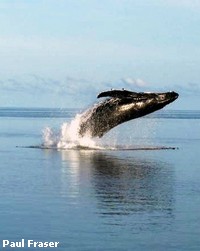
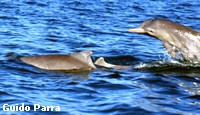
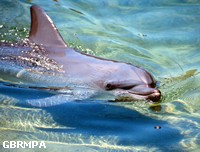
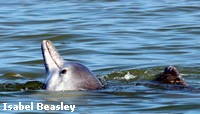
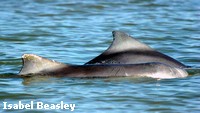


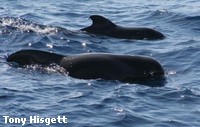
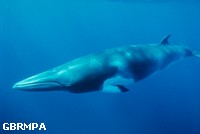
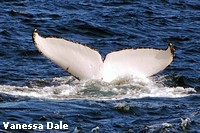
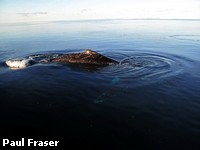
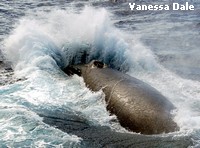
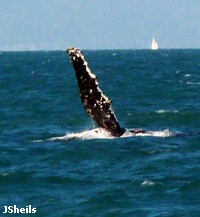
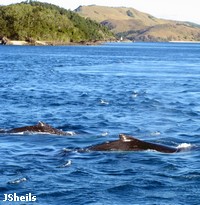
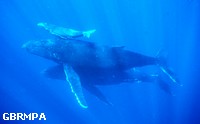
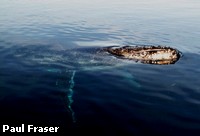
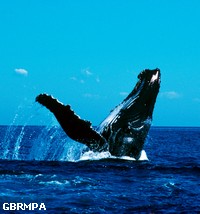
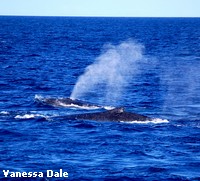
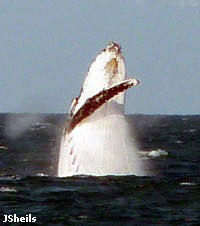
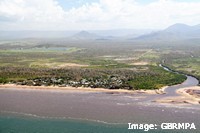
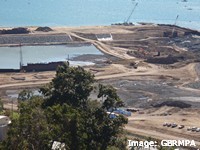
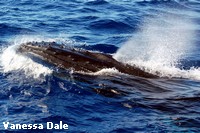
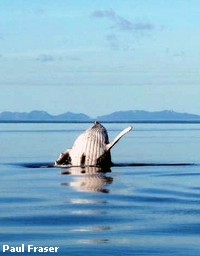
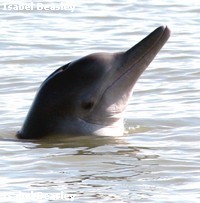
Whales and dolphins
The Whitsunday region is home to 4 species of dolphin and 4 species of whale.
- Common Bottlenose dolphin Tursiops truncatus
- Indo-Pacific Bottlenose dolphin Tursiops aduncus
- Indo Pacific Humpback dolphin Sousa chinensis
- Australian snubfin dolphin Orcaella heinsohnii
- Short finned pilot whale Globiocephala macrorhynchus
- Pilot whale Globiocephala sp.
- Dwarf Minke Whale Balanaeoptera acutorostrata
- Humpback whale Megaptera novaeangliae
Coastal dolphins in the Whitsundays
Dolphins are actually small toothed whales. They breathe through a single blowhole on the top of their heads. They solve the problem of not being able to see very far underwater, by sending out sound-clicks (sonar) which bounce off their target and return, allowing them to form a detailed 'image' of their surroundings and detect prey. They feed on fish and invertebrates, especially squid and cuttlefish, hunting both alone and co-operatively.
Dolphins live and hunt in small groups, and coastal species are often attached to a particular area. When dolphins sleep they alternate between the left and right sides of their brain, allowing them to remain alert and keep breathing as they sleep. They are known for their intelligence and have evolved complex communication abilities and examples of cultural practices that are passed on within groups. Most breed in summer, and since they have a 12 month gestation period, they calve in summer too. Females give birth every 3-6 years.
Bottlenose dolphins
Genetic studies suggest that there are more species of bottlenose dolphin than we thought. So far, two species of Bottlenose dolphin have been identified, and both occur in inshore waters of the Whitsundays. The Common Bottlenose dolphin Tursiops truncatus has a slightly shorter snout and is smaller in size than the Indo-Pacific Bottlenose dolphin Tursiops aduncus. Common Bottlenose dolphins usually live in offshore waters over 30m deep.
Common Bottlenose dolphins (Tursiops truncatus) are the 'typical' dolphin, as seen on TV. They are found in temperate and tropical waters worldwide. They sometimes associate with pods of Pilot and Humpback whales. Common Bottlenose dolphins grow to about 2.29m long and mature at around 12 years old, living 40 to 50 years.
Indo Pacific Bottlenose dolphins (Tursiops aduncus) are larger than Common Bottlenose dolphins, with males reaching 2.82m and females 2.79m. They mature at about 11 years old and may live over 40 years. They live in inshore and shallow offshore waters of the Indo-Pacific region.
Indo-Pacific Humpback dolphins (Sousa chinensis)
Indo Pacific Humpback dolphins have a distinctive, short, slightly recurved and triangular-shaped dorsal fin. They have a characteristic surfacing behaviour; first the beak rises steeply from the water, then the forehead appears, followed by the back, which is arched before they dive. They grow to around 2.6m long, maturing at about 13 years old and possibly living as long as 40 years.
In Australia, Indo-Pacific Humpback dolphins live in warm waters, over 22 degrees celcius, around the northern coast. They live mainly in coastal, estuarine, and occasionally riverine habitats less than 15 m deep. They live in small groups, within large home ranges of between 29 and 395 km². Due to their small group sizes, shy nature and turbid habitat, they are difficult to study and are not well known.
Australian Snubfin Dolphin (Orcaella heinsohni)
Mistakenly thought to be Irawaddy dolphins (Orcaella brevirostris), Australian Snubfin Dolphins (Orcaella heinsohnii) were first described in 2005. They were the first new dolphin species to be described for 56 years. Orcaella heinsohnii was named for George Heinsohn, the biologist at James Cook University, who in the 1970s first realised that they were distinct.
Unlike the grey Irrawaddy dolphins, they have 3 colour tones on their bodies: brown on top, lighter on the sides and white underneath. They have no snout and a rounded head, the appearance of a 'neck' and a small, snubby dorsal fin, making them look completely different to any other dolphin in Australia. Male Australian Snubfin Dolphins grow to 2.7m, females to 2.3m. They feed on coastal fish species and live in small groups. They may breed year round, their age at maturity and lifespan is not known.
They are only found in Australian and Papua New Guinean waters, ranging from approximately Broome on the west coast to the Brisbane River in Queensland. They live in shallow inshore waters less than 20 m deep, near river or creek mouths and near seagrass beds. Due to their shyness, small group size and their tendency to live in turbid they are difficult to study and not well known.
Whales in the Whitsundays
Short-finned Pilot whales (Globiocephala macrorhynchus)
The pilot whale species are nomadic and are only occasionally seen in offshore waters. Male Short-Finned Pilot Whales mature at about 17 years old and live for up to 46 years, while females mature at about 9 years and live up to 63 years. Males grow to a length 5.89m, while females are smaller at 4.8m. Short-finned Pilot Whales occur in tropical and warm-temperate waters world-wide, mainly at the edge of the continental shelf and over deep submarine canyons, although they also approach coastal seas.
Females reach sexual maturity at around nine years and 2.9–3.6 m in length. Mating occurs all year round, with calving spread throughout the year, with peaks in spring and autumn in the Southern Hemisphere. Gestation is 14.9 months and females suckle their calves for about two years. Even after weaning, female Short-finned Pilot Whales may continue to suckle their young for up to 15 more years!
They feed mainly on squid, cuttlefish, octopus and some fish species. They can dive to 300–500m depth at night, possibly feeding on species that migrate up from very deep water during the night. They live in small groups of between 10 to 30 individuals.
Dwarf Minke whales (Balanaeoptera acutorostrata subsp.)
Dwarf Minke Whales are an un-named subspecies of Minke whale, known as Balanaeoptera acutorostrata subsp.. Dwarf Minke Whales are the smallest of the baleen whales; they have hundreds of comb-like baleen plates inside their mouths. These are used to filter small fish and tiny crustaceans, called krill, from great gulps of water that they take into their mouths and force out through the baleen plates.
Males can grow to over 6m and females can reach over 7m, they may live as long as 60 years. Little is known about their life cycle and breeding habits. Dwarf Minke Whales mostly swim alone or in pairs, although groups may form at feeding sites. Dwarf Minke Whales are found year-round in tropical and warm temperate waters of the Southern Hemisphere.
Australian Dwarf Minke Whales live inshore, on the continental shelf of the Northern Great Barrier Reef, where they have been recorded from March to September, with a peak in June and July. The natural curiosity of these whales, with divers regularly being approached underwater, has made them a tourist attraction. Little is known about the movements of Dwarf Minke whales in the Whitsunday region.
Humpback whales (Megaptera novaeangliae)
Humpback whales are the whales most often seen in the region, when they visit en-masse during their annual breeding migration, between late June and late October. Sightings peak between July and early September as the whales gather in the region to breed and calve. Individual whales can be identified from clear photos of the black and white markings on the underside of their tails. Mostly whales return to the same area each year; there are separate breeding populations on the west and east coast of Australia.
The Whitsundays has long been known to be an important resting area for migrating Humpback whales. Recent research from the Murdoch University Cetacean Research Unit identified 2 areas used by Humpback whales in the region, one is thought to be important for breeding and calving and the other as a migration route.
Humpback whales can reach up to 16m in length and around 40 tonnes in weight. Called 'Humpback' whales because they have a raised area of blubber at the front of the dorsal fin on their backs, which curves distinctively as they swim on the surface of the water. The first part of their scientfic name, 'Megaptera' means 'big-winged', a reference to their huge pectoral fins, which can be up to 5m long.
Big show-offs
Humpback whales are the most acrobatic of the great whales, with lots of behaviours that allow us to see them above the surface of the water. These range from the 'blow', when they surface to breathe, to waving their huge pectoral fins, slapping their tails on the surface and breaching. Breaching is the most spectacular, it involves launching all 40-odd tonnes of whale out of the water with a few beats of their tail and then coming down with an enormous splash.
Humpbacks have been shown to be more acrobatic when sea surface conditions are rough; it has been suggested that breaching and slapping the surface may help them to communicate with other whales when there is too much surface noise for song to be heard properly. Your attention please! Alternatively they may just do it because they can!
The biggest eating the smallest
Humpbacks are baleen whales: they have hundreds of comb-like baleen plates inside their mouths. They filter small fish and tiny crustaceans, called krill, from great gulps of water that they take into their mouths and force out through the baleen plates. The pleats in their throats allow them to expand as the whales gulp large volumes of water. These throat pleats are a feature of the group of whales called Rorquals.
An epic journey
The humpbacks that visit the Whitsunday region feed over the summer in Antarctic waters, then migrate up the east coast of Australia to the Great Barrier Reef in winter to breed and calve. This is a 5000km round trip at about 7km per hour! During this epic migration, the whales live mainly off their own body fat, as there isn't much food for them in nutrient-poor tropical waters. Pregnant females are the last to arrive in the Whitsundays and the same females, now with new calves, are the last to leave on the southward migration in spring.
Making big babies
Gestation is 11 to 11.5 months, then Humpback mothers give birth to a calf up to 5m long and weighing up to 2 tonnes. At birth they would not survive in the cold Antarctic waters, so the females migrate enormous distances to give birth in warmer, tropical waters. Males migrate enormous distances to be on hand when the females are ready to mate!
Wandering minstrels
Male Humpback whales have complex and evolving songs that are thought to be important in courting females. They can be heard several kilometers away underwater; it is common for breath-hold and SCUBA divers around the Whitsunday Islands and outer reef to hear whales singing in winter. A study of Humpback whale songs found some males switched from the west coast migration to the east coast, bringing their distinctive songs with them. The new songs caught on and gradually were taken up by other east coast whales. Cultural revolution in whale songs
Feeding a hungry whale
Females suckle their calves from nipples inside slits in their lower abdomen. The milk is around 45% fat and as thick as toothpaste. On this diet, the calf increases from five to eight times its birthweight by the time nursing ends. This rich diet provides fuel for the long migration south, where young whales swim in their mother's slipstream as they run the gauntlet of natural predators such as sharks and killer whales.
Humpback life events
Young whales remain with their mothers for 12 to 18 months. Giving birth and suckling a calf while fasting and migrating is an enormous drain on the mother's resources; females usually only give birth every 2-3 years. Once weaned, calves don't start to breed until they are 4-8 years old and 11-12m long (Females are about 1-1.5m longer than males). They fully mature at 12-15 years old and live for more than 58 years.
Migaloo and MJ
An unusual white Humpback Whale was sighted off Byron Bay in June 1991 and has been sighted in the Whitsundays several times. He was named Migaloo, an Aboriginal word meaning 'Whitefella' and is so popular he even has his own website. Until September 2011 he was thought to be the only white Humpback whale in the world, until MJ (Migaloo junior), an all-white Humpback calf, was sighted in the Whitsunday islands. They are not thought to be genetically related. Because they are so popular, Migaloo and MJ have special protective legislation in Queensland, with approach distances of 500m for all vessels. Migaloo
Whaling
The coastal migration of Humpback whales made them relatively easy targets for the coastal whaling industry. Commercial coastal whaling started in Australia in the late 1820s. Whales provided oil for lubricants, lighting and cosmetics as well as 'whalebone' for corsets, made from their baleen. Southern Right whales were the main target, but by 1935 their numbers were too low and they were internationally protected, leaving Humpback whales as the next best choice.
On the east coast of Australia Humpback whaling started in the late 1940s. Between 1949 and 1962, the Australian east coast population, estimated to be well over 10,000 whales, was reduced to just a few hundred whales. Australian whaling ended officially in 1978, but most coastal whaling stations had closed by 1962 due to the low numbers of whales. Some scientists doubted that populations of humpbacks would ever recover, but the east coast population reached over 15,000 whales in 2010, and whales are once again a familiar sight in the Whitsundays in the winter months. University of Queensland: Humpback Whale abundance
Watching whales and dolphins
Seeing whales and dolphins in the wild is one of the most thrilling experiences you can have. It is important not to get carried away in your excitement, and push the encounter to the point where it disturbs the animal's behaviour. Whale watching rules are designed to protect both the watchers and the watched, and make sure everyone enjoys the encounter. The rules dictate how closely you can approach the whales, but not how closely they can approach you; whales are naturally curious and they sometimes come very close!
For more information on the best way to watch whales and dolphins:
GBRMPA: Whale and Dolphin Watching
Australian Government: Whale and Dolphin Watching
Queensland Government: Whale and Dolphin Watching
Threats to whales and dolphins on the Great Barrier Reef
- Entanglement in, and ingestion of marine debris, especially plastics
- Disturbance of breeding, birthing and nursing by boat traffic
- Disturbance or injury from underwater noise such as shipping, explosives and seismic testing
- Poor coastal water quality due to land-based runoff
- Loss or degradation of habitat due to coastal development
- Discarded fishing gear ('Ghost nets') and shark control nets which trap and drown marine mammals
- Commercial hunting in international waters
- Climate change threatens whales and dolphins by disrupting food chains that they depend upon
How you can help whales and dolphins...
- Go slow for those below!! Coastal dolphins feed in shallow inshore waters, visiting Humpback whales bask on the surface of the water: slow your boat speed and keep a good lookout to avoid striking marine animals.
- Report stranded or dead animals: call the marine Animal Stranding Hotline at RSPCA Qld 1300 ANIMAL (1300 264625)
- Avoid disturbing whales and dolphins when boating: do not approach closer than 100m and do not touch them even if they approach you. Encourage others to be considerate when boating around whales and dolphins. Australian National Guidelines for Whale and Dolphin Watching 2005
- Avoid littering the marine environment: pick up litter when you visit the beach, even if it isn’t yours!
- Water quality begins at home (and at work...)! Remember that the chemicals you use will ultimately end up in the sea. Use environmentally friendly chemicals; avoid artificial herbicides and pesticides if you can. If you have to use harmful chemicals, follow the instructions on the label carefully and avoid uses that might let chemicals wash into drains or waterways.
- Buy dolphin-friendly seafood products
- Check your crab pots regularly: animals die when they become entangled in poorly designed or abandoned fishing gear
- Support programs that promote whale and dolphin conservation
More information:
GBRMPA Responsible Reef Practices:
Get involved: Report whale and dolphin sightings:
Volunteer groups:
GBRMPA Tropical Topics: Whales and dolphins
Australian Government: Whales and dolphins
Marine Animal Stranding Hotline poster
Australian Government brochure: Harmful Marine Debris
Looking after protected species in Queensland: a guide for recreational fishers
Looking after protected species in Queensland: a guide for commercial fishers
Coastal Dolphins:
WWF: A case for legal protection; Australian Snubfin dolphin and Indo-Pacific Humpback dolphin
Indo-Pacific Humpback dolphin
IUCN Redlist: Indo-Pacific Humpback dolphin
GBRMPA: Indo-Pacific Humpback dolphin and Australian Snubfin dolphin Vulnerability Assessment
Queensland Government: Indo-Pacific Humpback dolphin
Australian Government: Indo-Pacific Humpback dolphin
CMS: Indo-Pacific Humpback dolphin
WWF: Indo-Pacific Humpback dolphin
Helene Marsh: Indo-Pacific Humpback dolphin review 2004
Australian Snubfin dolphin
IUCN Redlist: Australian Snubfin dolphin
Queensland Government: Australian Snubfin dolphin
CMS: Australian Snubfin dolphin
WA Marine Parks: Australian Snubfin dolphin
James Cook University: Description of a new dolphin species the Australian Snubfin Dolphin
Australian Government: Australian Snubfin dolphin
WWF: Australian Snubfin dolphin Fact Sheet
The Wilderness Society: Australian Snubfin dolphin
Australian Geographic: Australian Snubfin dolphin may face extinction
Indo Pacific Bottlenose Dolphin
IUCN Redlist: Indo Pacific Bottlenose Dolphin
Society for marine mammalogy: Indo Pacific Bottlenose Dolphin
Southern Cross University: Indo-Pacific Bottlenose dolphins
Australian Government: Indo Pacific Bottlenose Dolphin Vulnerability Assessment
GBRMPA: Indo Pacific Bottlenose Dolphin
Common Bottlenose Dolphin
Australian Museum: Common Bottlenose dolphins
Southern Cross University: Common Bottlenose dolphins
IUCN Redlist: Common Bottlenose dolphin
Society for marine mammalogy: Common Bottlenose dolphin
Australian Government: Common Bottlenose dolphin
Pilot whales:
IUCN Redlist: Short-finned Pilot whale
NOAA: Short-finned Pilot whale
Australian Government: Short-finned Pilot whale
Dwarf Minke Whales:
Reef CRC brochure: Dwarf Minke Whales
GBRMPA: Dwarf Minke Whales: A vulnerability Assessment
Australian Government: Dwarf Minke Whales
IUCN Redlist: Dwarf Minke whale
GBRMPA: Code of Practice for Dwarf Minke Whale Interactions
Humpback Whales:
Downloadable resources:
Australian Government brochure: Watching whales and dolphins safely
Australian Government brochure: The Humpback Whales of Eastern Australia
Queensland Government: Humpback whales
Websites:
Australian Government: Humpback Whales
Australian Museum: Humpback Whales
Australian Antarctic Division: Humpback Whales
Oceania Project: Humpback Whales
Society for marine mammalogy: Humpback whales
Queensland Government: White whales
University of Queensland: Cetacean Ecology and Acoustic Laboratory
Humpback whales spread songs across the Pacific
Identifying Humpbacks from tail photos
ABC Science: Humpback Whale breaks distance record
ABC Science: Humpback whales swim straight as an arrow
UQ News: Hour long songs woo females
Reports:
Australian Government: Humpback Whale Recovery Plan
Queensland Government: Distribution and Abundance of Group V Humpback Whales


